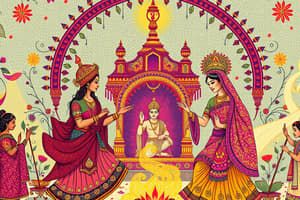Podcast
Questions and Answers
Which event symbolizes the triumph of good over evil?
Which event symbolizes the triumph of good over evil?
- Dol Purnima
- Lighting bonfires during Holi (correct)
- Ramanavami
- Chhath Puja
What is the significance of Holi celebrations in Kolkata?
What is the significance of Holi celebrations in Kolkata?
- Taking on a significant carnival atmosphere (correct)
- Hosting an international carnival
- Observing Ramanavami after Holi
- Commemorating Chhath Puja four days before Holi
Which southern state observes Ramanavami after Holi celebrations?
Which southern state observes Ramanavami after Holi celebrations?
- Bihar
- Karnataka (correct)
- West Bengal
- Maharashtra
What has allowed Holi to become a cross-cultural phenomenon in contemporary society?
What has allowed Holi to become a cross-cultural phenomenon in contemporary society?
Why do many countries host Holi celebrations?
Why do many countries host Holi celebrations?
What does Holi symbolize in the context of cultural diversity and collective expression?
What does Holi symbolize in the context of cultural diversity and collective expression?
What is the significance of colored powders in the festival of Holi?
What is the significance of colored powders in the festival of Holi?
In the context of Holi's history, who is associated with lamenting their dark complexion compared to Radha's fair skin?
In the context of Holi's history, who is associated with lamenting their dark complexion compared to Radha's fair skin?
Which mythological figure's devotion to Vishnu led to conflict with his demon father, Hiranyakashipu, in the origins of Holi?
Which mythological figure's devotion to Vishnu led to conflict with his demon father, Hiranyakashipu, in the origins of Holi?
How does the legend of Prahlada differ from the story of Krishna and Radha in the context of Holi?
How does the legend of Prahlada differ from the story of Krishna and Radha in the context of Holi?
What role does Narasimha play in the mythology surrounding Holi?
What role does Narasimha play in the mythology surrounding Holi?
What is the main theme that connects all the mythological narratives mentioned in the text?
What is the main theme that connects all the mythological narratives mentioned in the text?
Study Notes
Celebrating Colors: A Brief History of Holi
Every year, people across various regions of India and beyond come together to revel in a riotous display of color — it's Holi! This vibrant festival offers a glimpse into Indian culture's rich tapestry where tradition meets celebration with spectacular abandonment. Let's delve into the fascinating origins and evolution of this enchanting occasion known as Holi.
Origins and Mythology
The earliest mention of Holi can be traced back over two millennia through Sanskrit texts such as the Mahabharata and Harivamsa Purana. In these ancient works, there exist several narratives intertwining mythological figures like Krishna, Radha, Hiranyakashipu, and Nalakuvara & Manmatha. One popular legend centers around Krishna, who as a child, would lament his dark complexion compared to Radha, often depicted as fair-skinned. To remedy their disparity, Krishna playfully colors Radha's face with colored powders called 'Abir'. Thus, the act of throwing and playing with colored powder has its roots in this endearing tale between love and friendship.
Another myth entails the divine prince Prahlada, whose devotion to Vishnu earns him the wrath of his demon father, Hiranyakashipu. After many failed attempts to kill Prahlada, Hiranyakashipu finally decides upon a pyre ignited by flames from his sister's hands. However, Vishnu incarnates as Narasimha, a half-man-half-lion avatar, to rescue Prahlada from both the fire and his tyrannical father. People celebrate this victory by lighting bonfires during Holi symbolizing the triumph of good over evil.
Transformation Over Time
Over time, the origins steeped in religion and mysticism have taken on secular forms to become a festivity accessible to all classes and communities. As Hinduism spread throughout the Indian Subcontinent, so did Holi, albeit under different names and observances. For instance, Bengalis refer to Holi as Dol Purnima and Kolkata hosts a significant carnival atmosphere during this event. Similarly, Bihar commemorates Chhath Puja four days before Holi while southern states such as Karnataka observe Ramanavami after Holi is celebrated.
With colonization and globalization taking root, contemporary society embraces Holi as a cross-cultural phenomenon. Many countries host Holi celebrations due to diasporic populations and international interest alike. Attracted by the spectacle of colorful streets and exhilarating music, thousands flock to participate in the joyous chaos of Holi each spring.
In conclusion, Holi embodies the spirit of unity and renewal, bridging past traditions and modern times into one harmonious experience. Amidst the sea of vivid hues, one sees the beauty inherent in cultural diversity, tolerance, and collective expression. So let us join in the splendid kaleidoscope of Holi, connecting hearts worldwide through shared enthusiasm and respect for our rich heritage.
Studying That Suits You
Use AI to generate personalized quizzes and flashcards to suit your learning preferences.
Description
Explore the colorful history and transformations of the vibrant Indian festival, Holi, from its mythological origins involving figures like Krishna and Prahlada to its contemporary cross-cultural celebrations. Discover how this joyous occasion symbolizes unity, renewal, and cultural diversity.




